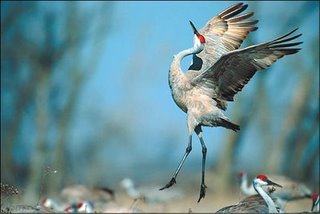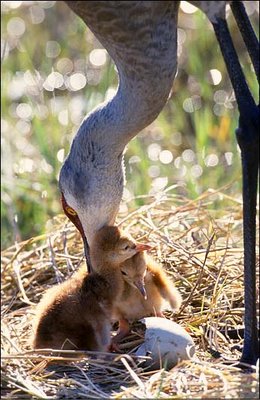

Cranes of The Platte River Valley
Ralph Bame called last evening and shared another wonderful live cam site for all of you ornithologists. This is National Geographic’s Crane Cam.
http://magma.nationalgeographic.com/ngm/cranecam/cam.html
Swirling gray masses of sandhill cranes descend on south-central Nebraska each year, heralding the arrival of spring and the largest gathering of cranes in the world. The Platte River Valley becomes a six-week pit stop from late February to early April for a half million sandhill cranes journeying north to their Arctic breeding grounds.
As one of the world’s oldest bird species, these elegant, red-headed birds—also known as Grus canadensis—have been a part of Nebraska’s landscape for more than nine million years. And for them, the Platte is the perfect place to take a break during their migration. Lean after traveling from their winter homes in New Mexico, Texas, and northern Mexico, these omnivorous cranes spend their days feasting in farm fields and wet meadows surrounding the Platte. Eating insects and waste corn enables them to pack up to two pounds (one kilogram) on their stately frames, which weigh 6 to12 pounds (3 to 5.5 kilograms) and roughly stand four-feet (one-meter) tall with a six-foot (two-meter) wingspan. This vital energy reserve helps ensure the cranes’ survival and reproductive success after they leave the Platte for Canada, Alaska, and Siberia.
The valley is also a critical migration stop for 20 million other northbound migratory birds, including highly endangered species such as the whooping crane, piping plover, and interior least tern. For several years conservation groups, farmers, and political leaders in Nebraska have been working on setting aside water for these birds and increasing their already preserved habitat from 14,000 acres (5,650 hectares) to 29,000 acres (11,750 hectares). In the near future they hope U.S. Secretary of the Interior, Gale Norton, and the governors of Nebraska, Wyoming, and Colorado—whose states use the Platte’s water—will sign an agreement to ratify the increase.Enjoy watching these magnificent birds.
This week the best viewing times are in the morning from 5:50 – 8:30 a.m. Central Time and from 6 p.m. to 8 p.m. Central Time. During this week 500,000 cranes are expected along this 80 mile stretch of the Pla
 tte.
tte.


0 Comments:
Post a Comment
<< Home